Socrative: Turn Student SmartPhones into Clickers
[Update: See a more recent post on new features.]
This is the tool I’ve been waiting for. Socrative turns your students’ smartphones into a powerful student response system. It’s like PollEverywhere (see this earlier post), but with greater flexibility and ease-of-use, the ability to attach student names to electronic quizzes, and free – even when you have more than 30 students. This promises to be a real challenge to the makers of student response systems.
You and your students have options for accessing Socrative. Access it via the website using a computer or any web-enabled mobile device. For the mobile devices, you can either just access the website, or you can download the free app (Android or iPhone). I tested it out by visiting the Socrative teacher site on my computer and using the student app on my Xoom.
Socrative includes a simulation on their website, so I took the liberty of taking screenshots. You can try it out yourself by going to the Socrative website, and clicking on “Hands-On Demo” in the lower right corner.
To experience it yourself, on your ‘teacher’ device, go to http://t.socrative.com. On your ‘student’ device, go to http://m.socrative.com. Yes, it’s just that easy. In class, you go to the ‘t’ website and send your students to the ‘m’ website. If you or your students have the app, just run the app.
Connecting student devices to the teacher’s device
On the lecturer’s device, you see “my room number”. When students run the app or visit http://m.socrative.com, they’ll be asked to enter a room number. They just enter the number you have on your device. You can change that number if you’d like. Just select “Change room number” (it’s on the bottom half of the menu, not visible in the screenshot). The number doesn’t have to be a number. It can be text, say, your name or the name of your course. Whatever you choose will be remembered both on your device and your students’ devices. The student’s device will show “Waiting for teacher to start an activity” until you, well, start an activity.
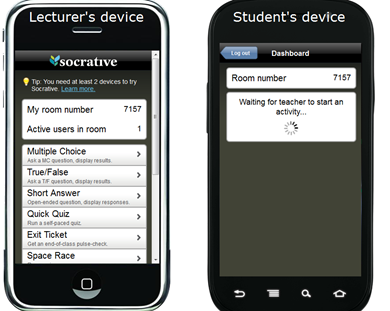
Multiple Choice Questions
Pose a multiple choice question orally, or by writing it on the board, or in your presentation slides. Tap “Multiple Choice”, and the students will be given A through E options.
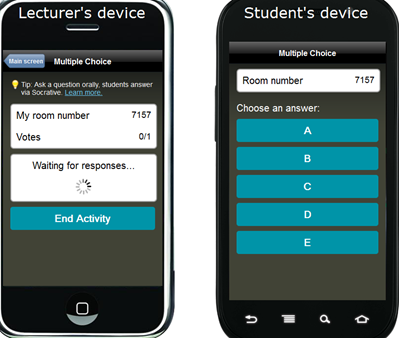
Once the student chooses, the instructor gets a bar graph, and the student’s device goes back into waiting mode. Unfortunately, at this time, there is no way to display this bar graph to students other than displaying your device using an opaque projector, or if you’re using your computer’s web browser, displaying the web page.
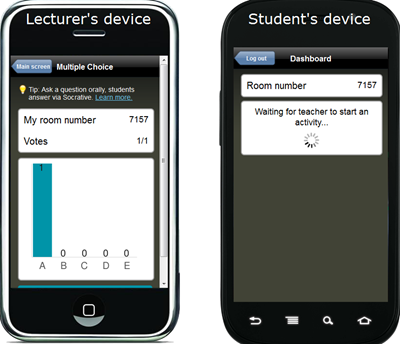
Short Answer Questions
Pose a short answer question to your students. On your device, tap “Short Answer”. That generates a response box on the student’s device.
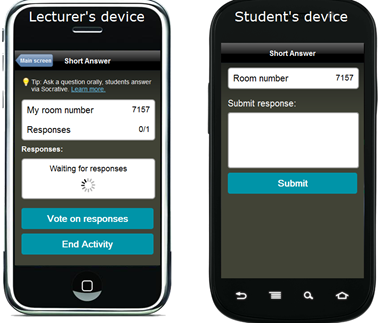
Here the student entered “I have no idea what the answer is.” That appears on your device, and the student’s device goes back into waiting mode.
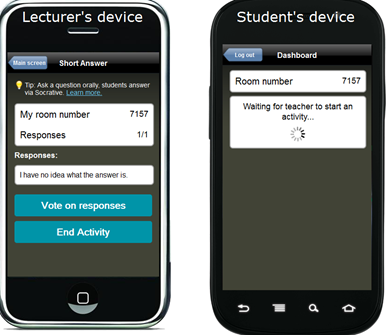
Now, if you’d like, you can have students’ vote on the best responses by tapping “Vote on responses.” Each student device now shows all of the short answer responses that were submitted. In this case, just one.
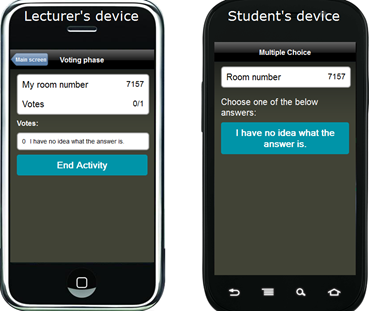
Quick Quiz (Self-Paced)
In a quick quiz, you give students a set of pre-planned questions. After a student submits one question, they move onto the next one, and the next until they’re finished. The first question should be their name.
Here you can see that there is one active user in the room. We know that because that’s how many devices have entered the Socrative room number. At this point, no one has completed the quiz.
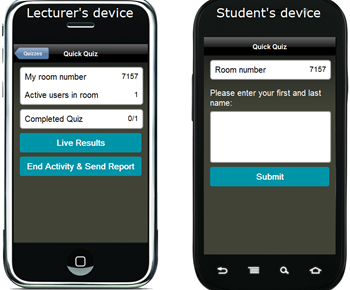
The student has answered all 4 questions in the quiz. On the lecturer’s device, click “Live Results” to see who has responded and how they did. Once everyone has completed the quiz, click “End Activity & Send Report.” An Excel spreadsheet will be soon emailed to you with all of the data from the quiz.
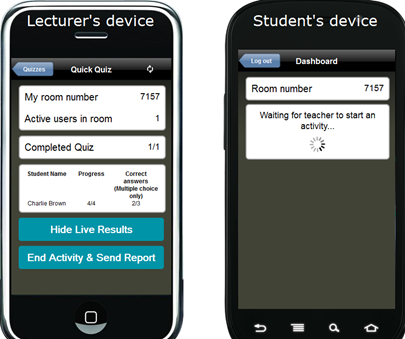
This is what the spreadsheet looks like. The green-filled boxes are correct answers; the red-filled are incorrect.

Tip: On the quizzes, change the first question about name into two questions. Question 1: Enter your last name. Question 2: Enter your first name. When you get the spreadsheet, you can sort by last name for easy entry into your gradesheet.
Exit Ticket
The Exit Ticket works in much the same way as quizzes. With 5 to 10 minutes left in class, click “Exit Ticket” and students respond with their name and quick responses to a question, such as “define independent variable.” Research has shown that responding to open-ended questions related to the course content at the end of class improves performance on exams. [See for example: Lyle, K.B. & Crawford, N.A. (2011). Retrieving essential material at the end of lectures improves performance on statistics exams. Teaching of Psychology, 38, pp. 94-97.]
The Exit Ticket should be editable, but as of this writing it doesn’t appear to be. Instead, you can accomplish the same thing by giving a Quick Quiz since the Quick Quizzes are editable.
Space Race
Students compete in small groups (maximum: 10) to answer your pre-loaded questions as quickly as they can. The team that gets the most right in the shortest amount of time wins. Again, when you’re done, click the “end activity & send report” button at the bottom of your screen (not shown). You’ll be emailed an Excel spreadsheet with the results.
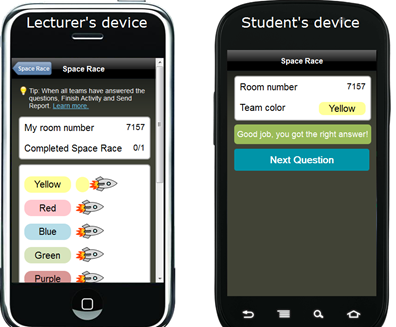
CONSIDERATIONS
Not all students have smartphones, laptops, netbooks, or other portable web-enabled technology. On the quizzes and the exit ticket, once a student is done responding, they’re given the option to finish or let another student take the quiz. For activities that could potentially have points attached, there’s at least this option. If many of your students don’t have internet access in your classroom, consider pairing students so that the two of them provide one response.
I anticipate trying this out in the fall. If anyone tries it before I do, I’d love to hear what you and your students think of it!
Thanks to Free Technology for Teachers for posting on this technology!